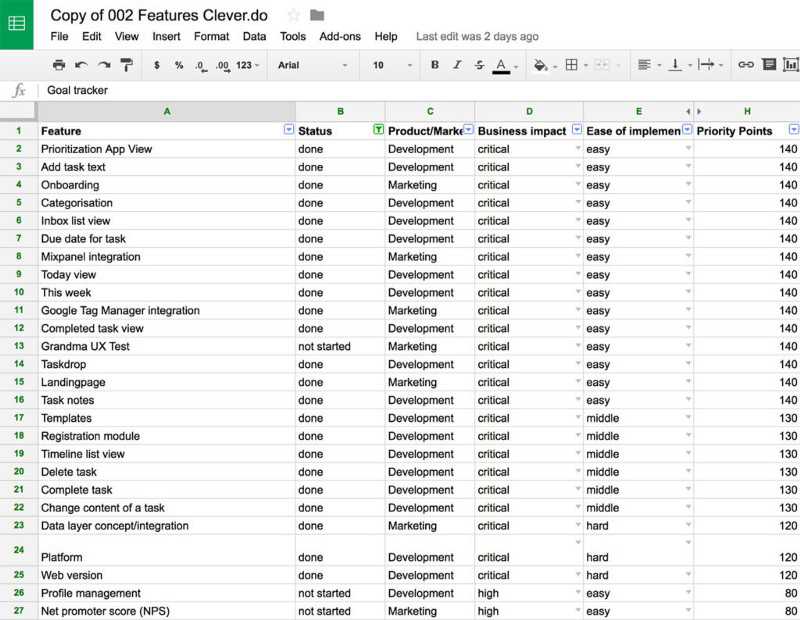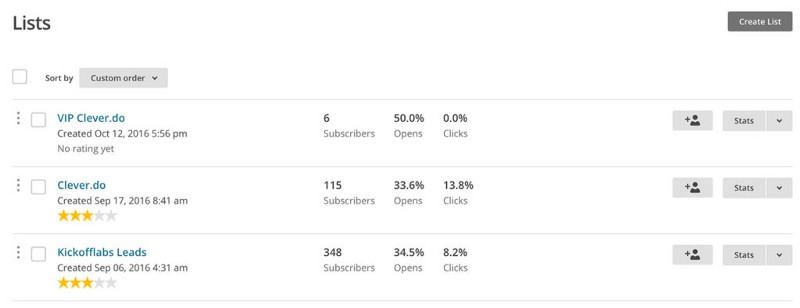I spent five years running a consulting business. Two years ago, I gave away everything I owned to a friend. I moved to a new country and joined Libertex as a management board member. Last year, something bad happened to me: on the 31st of December, a family member passed away. It was one of the worst events in my life. After recovering from the shock, I realized I need to change something. I had spent lots of time focusing on the wrong things.
The first thing I did was delete my Wunderlist account. Wunderlist did one thing well: it drove me crazy with hundreds of unfinished daily “to-dos.” I started to search for time management hacks, and found a hack from a former LinkedIn executive. I used it for a while and realized it helped me to be a lot more productive. So, my girlfriend, Anastasia, and I decided to build Clever.do in our free time.
Anastasia started with customer development on Linkedin. Two weeks later, it was clear that people have problems setting their priorities. Since we wanted to build Clever.do for ourselves first, there was no real user testing needed in the beginning. We immediately jumped into the creation of wireframes. I used the free version of Balsamiq for that. After a few tries, we managed to create wireframes for the first version. It took us one weekend to build these. As I’m a terrible writer, I recorded three screencasts to explain how the app should work. I uploaded them to YouTube to show them to designers and engineers:
I spoke with some folks about the correct technology stack to use. The original idea was to create an app for mobile, desktop, and web. To be lean, we needed something where most of the source code is reusable. I even bought an hour of email consulting from an HTML5/Ionic specialist. We made a decision to use Firebase, HTML5 and AngularJS 2. Now it was time to find a developer for our project.
In 2009, I studied in Australia. While there, I spoke to a guy who ran a startup program at the University. I wanted to raise some money for a student startup, and he gave me the following advice: try to pitch your idea to the “3 Fs” — friends, family, and fools. I used a modified formula to find a developer. Instead of talking to fools, I found something better: Facebook. I asked all my friends, hackers, and hustlers on Facebook for contacts.
Booom! Two hours later, I got a message from a developer and pitched him the idea. We made an agreement on payments and he started to work on a prototype. The first version of our prototype was pretty ugly, but it was enough. At the same time, I created a product requirements document (PRD). It helped a lot to create a separate features list with priorities. Every feature has business impact and ease of implementation. Google’s performance team uses this framework all the time. They gave it to me during an another project. ( Here is a clean copy you can duplicate and reuse for your own projects.)
It was the middle of July and everyone was ready to go on vacation. At this time, I scored the biggest screw-up of the project. Instead of using my magic “3 Fs” formula to find a designer, I hired a guy who did a redesign of Google Play. He’s experienced, crazy fast, and did amazing work. But it was too expensive for an MVP. We paid him $6,500 for the initial design (5 screens or so). And every change would cost us a hell of a lot of money. Back then, I wasn’t experienced in building products. I didn’t know that we were going to change everything again and again. We changed our original design 10 times or so, but with another designer.
“The first draft of anything is shit.”
— Ernest Hemingway
In parallel, Anastasia started to acquire our first beta sign-ups. She built a landing page and started to drive some traffic from Facebook. Back then, she had no clue how to build performing landing pages. She managed to get a 30% conversion rate from visit to sign-up — it blew my mind. We spent approximately $1,498 on Facebook ads, and acquired 348 beta users.
In September, everyone came back from vacation. Our developer started to work on the MVP. He took the documents, asked me questions, and disappeared. After three weeks of coding, or whatever he did, he came back. He showed me the alpha version. We set to work fixing all critical bugs, and, on October 12th, Clever.do went live. I paid him exactly $3,082 for his work. It was the best decision that I made. We were lucky to work with such a talented and hardworking person: no meetings, no talks, no bullshit.
After finishing the first version of Clever.do, I realized we used AngularJS 1 instead of the second version. At the beginning of the project, I thought this was an important thing. But now, I don’t care about the technology stack. As long as our developer builds a stable product, everything is fine. If you want to build an MVP, don’t spend lots of time thinking about it. Try to get “some shit” done — you can always rewrite it later.
Our total expenses to release MVP (without advertising costs) were:
- UX/UI design: $6,500
- Development: $3,082
- Content (value proposition and landing page): $240
- Website template: $64
- HTML5 consulting: $70
Total: $9,956
You can copy and reuse our current profit/loss calculation. Also included is a revenue projections calculator, which is very helpful if you need to make forecasts. But be aware:
“Projections are just bullshit. They’re just guesses.”
— Jason Fried, Basecamp
What I learned from building an MVP of Clever.do:
- Start to solve your own problems first.
- Build a network of people with different skills. Connect with them via Facebook, Twitter, LinkedIn, Medium, email,
- Make a commitment to work over a long period of time with no tangible results.
- Don’t hire an expensive designer for initial design or MVP.
- Hire an experienced developer by using my magic “3 Fs” formula.
- Don’t spend time on building a website. (Psst: LaunchRock)
- Release fast, validate your ideas, learn new stuff, and iterate. Remember: “The first draft of anything is shit.”
My whole life is like a big entrepreneur’s journey. From 5 A.M. in the morning ‘till late in the evening, I generate tons of new ideas.
But I didn’t realize any of them to their full potential—because most of them weren’t solving my own problems. In order to be successful—start with solving your own problems, first. I think this is the reason behind my persistent passion for Clever.do.




